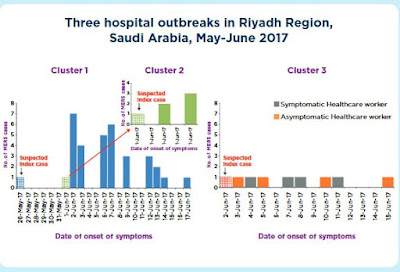 |
| Credit WHO EMRO |
#12,605
Although it pales in size to some of Saudi Arabia's earlier nosocomial outbreaks (see chart above), last months' 3-hospital outbreak in Riyadh was the largest spike in MERS cases we've seen in over a year.
Over a 3 week span 48 cases were reported as connected to this outbreak (see chart below), with at least six fatalities. More than half of the cases were listed as asymptomatic, discovered during the testing of contacts, which helps to explain the low case fatality rate (CFR).
 |
| Credit WHO EMRO |
On the 18th of June daily reporting from the MOH ceased for 6 days, and then resumed on the 26th, albeit with some days missing. Since then, reported MERS cases have slowed markedly, with only 3 new cases announced since then.
The WHO's EMRO MERS update, published yesterday, provides an excellent graphical update and representation of MERS, with both historical information, and a focus on recent cases and clusters.
Follow the link to read or download the full report.
MERS situation update, June 2017
- At the end of June 2017, a total of 2039 laboratory-confirmed cases of Middle East respiratory syndrome coronavirus (MERS-CoV), including 730 deaths (case–fatality rate: 35.8%) were reported globally; the majority of these cases were reported from Saudi Arabia (1671 laboratory-confirmed cases, including 656 deaths with a case–fatality rate of 39.3%).
- During the months of May and June 2017, 3 simultaneous hospital outbreaks of MERS-CoV were reported from 3 different hospitals in Riyadh city, Riyadh Region in Saudi Arabia, of which 2 clusters are related. A total of 48 cases with 6 related deaths were reported from these 3 hospital clusters (CFR: 12.5%). The date of reporting of last laboratory-confirmed case from these 3 hospital clusters was 17 June 2017.
- The demographic and epidemiological characteristics of the cases reported in 2017 do not show any significant difference compared with cases reported during the same period from 2012 to 2016. Owing to improved infection prevention and control practices in the hospitals, the number of hospital-acquired cases of MERS has dropped significantly in 2015 and in 2016 compared to previous years.
- The age group of those aged 50–59 years continues to be the group at highest risk for acquiring infection as primary cases. For secondary cases, it is the age group of 30–39 years who are mostly at risk. The number of deaths is higher in the age group of 50–59 years for primary cases and 70–79 years for secondary cases.
Read the MERS situation update, June 2017
